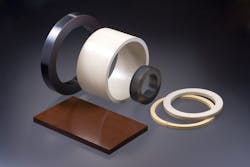Keep Up with Plastics: The Rise of Thermoplastic Composites
Key Highlights:
- Polymer science advancements are leading to a tenfold increase in plastics use in motion control components within five years.
- New thermoplastic composites approach metal strength and modulus but with 40% lower density, enabling lighter, stronger parts.
- Injection molding of complex geometries in a single piece reduces manufacturing time, energy use, and simplifies engineering workflows.
Polymer technology in mechanical engineering—it’s been around for years, but it’s now rapidly ramping up. With the recent advancements in thermoplastic composites and the ability to create custom compounds with very specific attributes, many design engineers are now using plastics in places previously never considered. From new thermoplastic composites to cutting-edge adhesives, we have already entered a new “polymer” era in machine and motion system design.
“I would say that in five years, the use of polymers in various motion control components will be 10 times what it is now,” says Dan Cedrone, director of Technical Sales and Application Development at Ensinger Plastics. “Polymer science is making huge contributions to the engineering design community. Although relatively new to engineering design, continuous advancements provide design liberties that were unheard of 10 years ago and showing no sign of slowing down.”
Polymer makers are therefore investing heavily in new infrastructure to increase capacity, in Ensinger’s case for both traditional oil-based polymers and its mass-balanced bio-based plastics made from materials such as wood-processing byproducts.
READ MORE: High-Performance Plastics for Friction and Wear Applications
But besides the availability of “greener” plastics, there are huge general sustainability gains in using composites, explains Dr. Keith Hechtel, VP of Business Development & Marketing at Curbell Plastics, a U.S. distributor for advanced plastics/plastic composite manufacturers such as Ensinger, Röchling, Mitsubishi Chemical Group, DuPont and ITW Performance Polymers.
There are revolutionary efficiencies to be had, says Hechtel, due to the fact that the new plastics having unprecedented strength attributes but weighing much less than metal. (And read more about technical characteristics of cutting-edge plastics in Hechtel’s recent Members-only Machine Design article.
Beyond plastics in components, there are also sustainability benefits in using methacrylate adhesives to join parts made of metal (or many other industrial materials) instead of welding. “These adhesives are faster than welding, waterproof and extremely strong,” Hechtel reports. “You also reduce the chance of rust developing over time, which is commonly seen with welds of two different metals. So, there are efficiency gains in manufacturing the item as well as less maintenance, repair and replacement over time.”
Strength and More: Why Thermoplastic Composites Change the Game
As Hechtel explains, today’s thermoplastic composites have strength and modulus values approaching those of metals, but with a density 40% lower than aluminum. Plastic parts thus weigh less without compromising structural integrity. One example is polyamide plastics that have been used for years in the sheaves of construction cranes, making the crane lighter (and therefore having greater load capacity) than cranes with metal sheaves.
An added benefit with thermoplastic composites is that they can be quickly formed on heated match dies. This allows manufacturers to create strong, thin-walled parts much more quickly, says Hechtel, with a smaller carbon footprint than using the hand lay-up processes used with traditional fiberglass materials.
Another polymer category with unprecedented strength and weight-bearing capacity is carbon fiber-filler thermoplastics. With them, a part with complex geometry can be made in one piece. “Previously, you would have to produce two or more parts and join them with welding or rivets to finish the completed part with the complex shape,” says Hechtel. “With the new thermoplastics, you can injection mold that complex geometry in one part. This saves manufacturing time and energy use, and also greatly simplifies the engineering workflow.”
READ MORE: The Belt Doctor’s Prescription for Longevity in Motion Control
Cedrone further explains that the amount and type of fillers (carbon fiber, nanotube, Kevlar, glass, PTFE and more) provide the ability for plastics companies to modify compressive strength, tensile strength, electrical properties and other characteristics.
Ensinger’s TECATEC thermoplastic composites, for example, combine resins with one of a range of unique woven fabrics. “We can combine carbon fiber woven fabric with resins such as polycarbonate, Nylon, or Ultem to accommodate the properties required for a specific application,” Cedrone says.
That application might require a material with more strength, for example, or the ability to dissipate static electricity or enable conductivity. It sounds like science fiction, but Ensinger already has created “a graphitic bipolar plate material called TECACOMP that is more conductive than steel.”
More Plastic, Less friction: Energy Savings in Conveyors
Plastics are also enabling huge efficiency gains in conveyors. With the typical steel drag chain running along a steel or concrete track in the factory floor, large amounts of power are needed to overcome chain friction and keep conveyor speed steady. The friction also contributes to high wear rates—and each time a component in any system must be replaced, the total carbon footprint of the system goes up.
In five years, the use of polymer technology in motion control components will be 10 times what it is now.
This all changes with the use of new under-chain wear strips made of Ultra High Molecular Weight Polyethylene (UHMW-PE). Hechtel explains that adding these strips dramatically reduces friction/power use, even making the use of a smaller motor possible. “These strips can be incorporated into smaller conveyors up to very large conveyor systems,” he says, “for example, for moving an automobile chassis along a vehicle assembly line.”
Seals made of low-friction plastic materials that posses moderate modulus values also reduce actuation torque and reduce the size of the required electrical, pneumatic or hydraulic actuator motor, Hechtel says.
Cedrone adds that extremely high performance, self-lubricating plain bearings are now available, some of which have compressive strength of over 40,000 psi. Various bearing materials can now tolerate conditions of temperatures over 600°F, aggressive chemical exposure, underwater and vacuum.
“These high-performance materials give designers freedom,” says Cedrone. “More than they realize.”
Growing Use Across Many Components: Bearings and Seals
The use of plastics in pivot and rotary bearings is already common in robotics, food conveyor and medical device sectors. Composite bearing materials also increase the lifespan and lower the maintenance requirements in applications such as railroad braking components, pivot bearings in heavy equipment bucket systems and bridge expansion joint bearings.
Cedrone notes that self-lubricating plastic bearings excel in applications where there is both high load and vibration due to their ability to better mitigate aggressive vibration and exposure to chemicals and UV, compared to their metallic counterparts. There are already millions of plastic bearings being used in railway applications.
In other applications where vibration is a factor—for example, in heavy equipment such as grinders, gravel crushers, hoe rams and paving equipment—there’s also growth in adoption of plastic sprockets and gears. More plastic high-load thrust washers are also being used in the transmissions of heavy equipment and automobiles.
Expanding Applications Across Industries
As polymer technology makes further progress, Cedrone predicts that engineering with plastics will become part of the curriculum in engineering schools.
At the same time however, existing design engineers at the OEM level need to be able to keep up with what’s available. New plastics are literally released every month now from the major firms. For example, Ensinger has just released a new bearing-grade self-lubricating composite material with a compressive strength of 50,000 psi which can withstand long-term temperature exposure up to 400°F (and 500°F short term).
READ MORE: High-Performance Plastics: The Value and Challenges of High-Volume Precision Molding
The firm has also just released an acetal homopolymer with a very high modulus of stiffness and rigidity, among other attributes, suitable for gear and sprocket applications in automotive and e-bike applications in wheels, rollers and conveyor components.
To help fill this gap, companies offer experienced technical teams that walk engineers through the process of material selection for specific applications, including customized options. Ensinger also, upon request, can provide free technical “lunch and learn” seminars on-site for several polymer topics.
And as knowledge and experience with plastics grows among engineers and technicians, similarly to any new technology, usage will grow in parallel.
Cedrone points to larger gears as an example. While those working in many industries have always taken the tried-and-true approach of machining larger gears out of metal, there is increasing interest in using polymer instead, due to the advances in strength, durability and more than have been achieved.
Those advances will continue, and looking forward, Cedrone believes that as plastic components “find their way into new applications such as autonomous vehicles undersea, on land and in the air, trust in composites will grow rapidly.”
About the Author

Treena Hein
Treena Hein is an award-winning science and technology writer with over 20 years’ experience.


